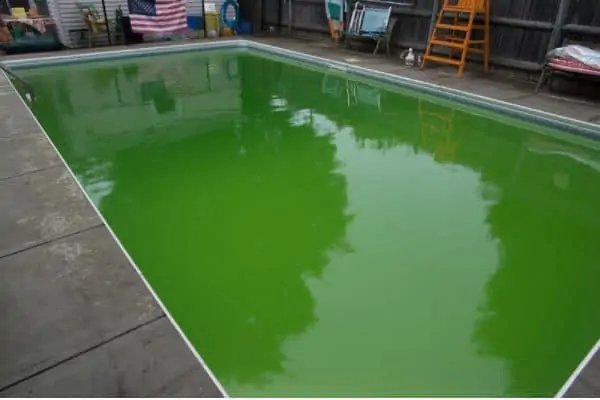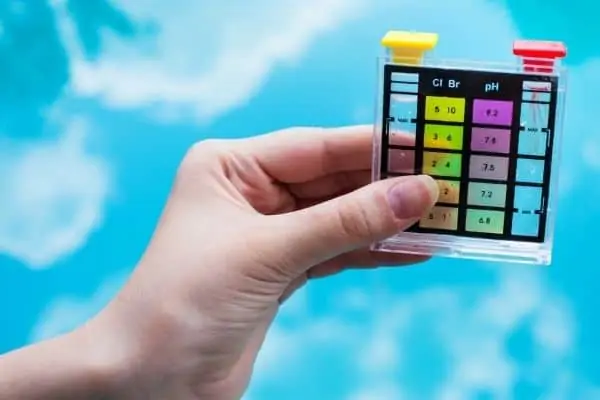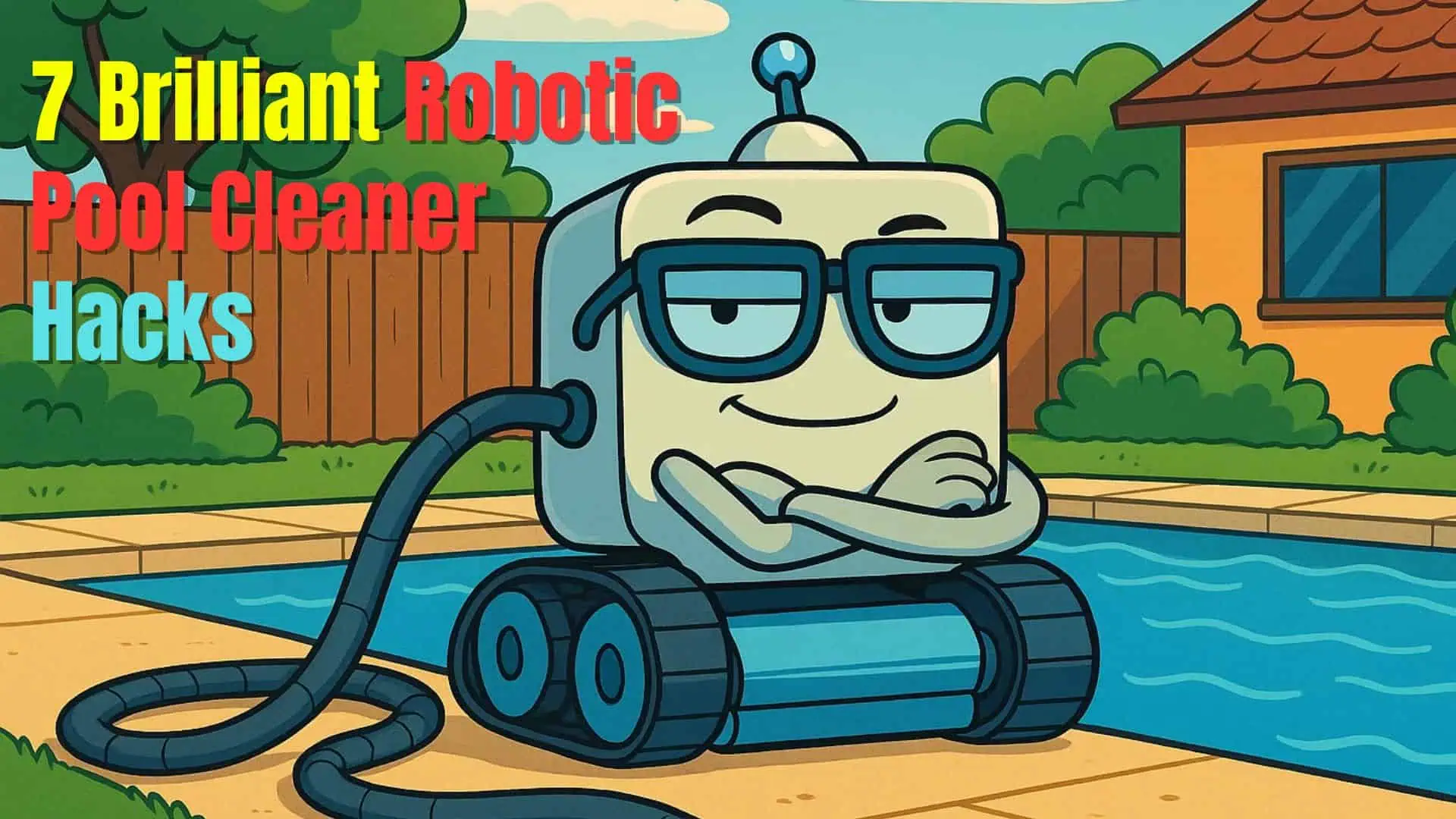You have a pool and keep it nice and sparkling by adding chlorine tablets each week. Then, one day, your pool suddenly turns green, so you add more chlorine, but it stays green. You test the chlorine level, and it is high, so why is it still green?
When the chemicals are unbalanced, a pool can be green but have high chlorine levels. Too much combined chlorine, high pH levels, and high cyanuric acid (CYA) levels can make the chlorine ineffective, potentially causing algae to grow.
These are just the basics of why your pool is green but chlorine is high. Understanding how to fix this problem is important. There are several facets to pool care that can cause a green pool, learning which will help you create an ever-sparkling pool.


I Have Algae in the Pool, but Chlorine Is High.
Most pool owners know that chlorine kills algae, so it doesn’t make sense to them that there are algae in the pool, but chlorine is high – if there is plenty of chlorine, why is the pool still green?
Although this may be true, there are many reasons why the chlorine in the pool may not work.
1. Little or no free chlorine
To understand this, we need to explain the three “types” of chlorine in your pool:
- free chlorine
- combined chlorine (chloramines)
- total chlorine.
What is free chlorine?
Free chlorine is the amount that hasn’t been used up in effect, so it is still available to kill algae and deal with other contaminants.
What is combined chlorine (chloramines)?
Free chlorine reacts with other things in the water, killing unwanted algae and other contaminants. When it does so, it reacts with them to form combined chlorine, also known as chloramines. Once this happens (sometimes called “chlorine lock”), it is effectively used and no longer available to keep the pool clean.
What is total chlorine?
As the name suggests, total chlorine is the total amount of chlorine in the pool, including both the free chlorine and the combined chlorine.
When you measure chlorine, you measure the total amount of chlorine in the pool, meaning there might be more combined chlorine than free chlorine despite high total chlorine readings.
I suggest that you use a test system that measures the free and total chlorine in your pool. This way, you will know what the actual situation is regarding chlorine in your pool.
The JNW Direct Pool and Spa Test Strips give readings for total and free chlorine, total hardness, pH, CTA (stabilizer), total alkalinity, and even bromine if you use it.
2. Cyanuric acid (CYA)
What is CYA?
CYA is short for Cyanuric acid. It is used as a chlorine stabilizer in pools to prevent too much chlorine from being lost due to the action of the sun. If you use chlorine tablets or granules, they will likely include a certain amount of cyanuric acid.
If you see trichloroisocyanurate, potassium dichloroisocyanurate, or sodium dichloroisocyanurate on the labels of your chlorine, then it contains a stabilizer.
Over time, the CYA levels can increase to levels that may start to reduce the effectiveness of the chlorine. If it reaches levels above 50 ppm, algae can grow, and the pool turns green.
If you are unsure what to do with CYA, then read How to add stabilizer to pool
How to lower cyanuric acid in pool
The most common method of reducing the cyanuric acid levels in a pool is to partially drain it and then refill it to dilute the CYA in the water. For example, you may need to drain the pool if your levels are very high, over 100 ppm.
CYA reducer products, such as the Bio-Active Stabilizer reducer, are on the market. These products will bring down your CYA levels if you do not want to drain and refill your pool partially.
3. Incorrect pH
The acid levels in your pool affect how chlorine reacts. Your pool may well be green, but chlorine is high, and pH is low, too.
Too little CYA, and sunlight eats up the chlorine. Too much acid, and chlorine is blocked from working effectively. The acid levels in your pool will not kill bacteria or algae, but they will determine how effective the chlorine will be.
The pH measurement determines how acidic or basic the water is in your pool. Areas with high rainfall will have more acidic water, while people who use well water may have more basic water. Both levels can damage your skin but will also determine how effective chlorine is in dealing with algae.
A good range for pool water is to have a pH level between 7.2 and 7.8. This means that not only is it comfortable to swim in, but more importantly, chlorine can work properly.
If the pH is lower than 7.2 (therefore acidic), you must consider adding an alkaline, such as pH+, baking soda, etc, to raise the pH. If the pH is above 7.8 (therefore alkaline), you need to consider adding an acid such as muriatic acid to lower the pH.
4. High phosphate
High phosphate levels can also cause algae to thrive (as phosphate is plant fertilizer and algae is a plant).
However, this isn’t generally a problem for many pool owners, particularly those who live in towns and cities and away from trees. It can build up by high levels of leaves and other organic material being blown into the pool and in rural areas if fertilizer from surrounding fields runs off into your pool during rain.
To prevent a phosphate build-up in the future, try to remove leaves and other organic matter promptly before they have a chance to break down.
5. Is your filter running for long enough?
If your pool pump is not running for long enough each day, then it is possible that the water is not being filtered sufficiently enough, allowing the water to become green.
You have to let the pool filter run for long enough each day to filter the pool’s total volume at least once. This often works out to around eight hours.
To work out how long yours should run for, read my article – How long should you run a pool pump
What to test for when your pool is green but chlorine is high
Test the chlorine
Knowing how much chlorine is in the pool is relatively easy to test using a good test kit or strip. Make sure that your test strips have both the total chlorine and the free chlorine.
The ideal level for free chlorine is 2-4 ppm; combined chlorine should be less than 0.5 ppm. If your readings are in this range, you need to look further by checking the pH levels.
If the combined chlorine is high but the free chlorine is low, that is the most likely cause of your problem.

Test the pH
If you have thrown a lot of chlorine in the pool but it stays green, test the water for pH levels. This is often the case after a lot of rainfall, as the rains increase the acidity levels in a pool while diluting the chlorine.
The most likely reason a pool has high chlorine but is green is that the pH levels are too low, causing the chlorine to be ineffective. High acidity (low pH) in the water does protect the chlorine from being used up by the sun but stops it from reacting with algae and other things.
The pH should be within the range 7.2 to 7.8. If it is below 7.2, add some alkaline to bring the level into this range. Please read my post How to raise the pH in a pool for instructions.
If the pH is within the range, you should test for phosphates.
Recommended Test Strips
Test for phosphates
Most home pool water testers will not show phosphate levels, so you may need to take a water sample to your local pool store for them to analyze.
You can buy a phosphate test kit – the Aquacheck Phosphate Test Kit is inexpensive.
If the phosphate level in your pool is high, you can buy chemicals to reduce it. One of the most popular on Amazon is the Clorox Pool&Spa 55232CLX Phosphate Remover. Make sure you follow the manufacturer’s instructions.
How to fix a green pool with high chlorine?
Once you have determined why the chlorine is high but not working and used the methods above to correct it, you can move on to getting rid of the algae.
Shock the pool
Shocking the pool does two things to kill the algae and bacteria in the pool:
- the first is adding more chlorine
- the second is releasing the combined chlorine in the water.
We recommend always checking the possibility of adding a quick shock treatment when struggling with a green pool.
All shock treatments will have measurements on the back that you need to follow, the chief of which is the pH levels in your pool. When you are about to shock your pool, you must ensure that all the other chemical levels are perfect for the best possible results.
Once the algae is dead, it will lie on the bottom of the pool. The only easy way to get rid of it easily is to vacuum the pool to waste as all the algae will be expelled from the pool.
Drain and add new water
Draining your pool, at least partially, and then topping up the water will help reduce the amount of combined chlorine, phosphates and the water’s pH. This will have the effect of almost starting again from scratch, enabling you to remove algae and adjust the chemicals properly.
Do not use algaecide
Algaecide is not used to kill the algae in a green pool as it is used more as a preventative measure to prevent it from growing in the first place. However, many people add algaecide and wonder why they still have green pool water.
Shock chlorine will also help prevent the algaecide from doing anything.
Conclusion
You may still have algae in the pool, but chlorine is high. That could be because your pool will be green even with high chlorine when the chlorine is prevented from working. You need to work out why chlorine is not available to kill the algae and then take steps to correct it.
FAQs
Why is my pool still green after adding chlorine?
Your pool is probably still green even after adding chlorine because you have too little free chlorine, the pH of your water is incorrect, or you could have high phosphate levels.
Why does my pool turn green when I add chlorine?
This usually happens when the pH in the pool is incorrect. It should be between 7.2 and 7.8
Is it safe to swim in a green pool?
Although algae grow in natural ponds and lakes, and people swim in them, swimming in a green pool is probably not such a good idea. While many people will be safe, it may affect some. So, if in doubt, don’t swim; eliminate the algae using pool shock to kill it.
Can you swim in a pool with high phosphates?
It is safe to swim in a pool with quite high phosphate levels. If the levels are over 1000 ppb, then it can become dangerous.








Leave a Reply